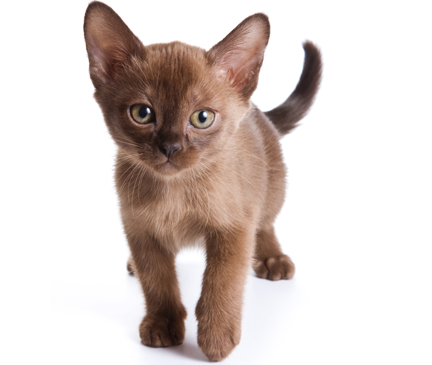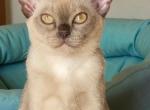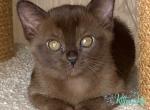

Burmese Cat Breed Description
Burmese Traits At A Glance
Active
Playful
Requires Attention
Affectionate
Vocal
Docile
Intelligent
Independent
Health
Grooming
Child Friendly
Pet Friendly
Hypoallergenic
Size: They will shock you with their weight, as they are heavier than they appear. They weigh, on average, 8-12 pounds.
Characteristics: They have round eyes that are both intriguing and endearing and will bore their way right into your soul. The European Burmese is described as having a longer, more narrow muzzle, with a less pronounced nose break and a more narrow head. The other major conformation of Burmese has a more round head, broader muzzle and more pronounced nose break. Additionally, this conformation tends to have a shorter body. This conformation is the apparent "super model" body type of the Burmese and tends to be been seen more in show cats. They do not shed much and require minimal grooming, making them a great, low-maintenance companion. Once you look into the expressive eyes of this sweet cat, you are sure to fall in love forever.
Temperament: Burmese cats are fun, gentle, sweet, loving companions for anyone and are wonderful with families and children. They are often described as the most affectionate cat breed and are ideal pets for families as they get along quite well with people of all ages, including very young children. They can be quite entertaining and adventurous, especially as kittens. They love to play, climb and leap! Watch your head because they may try to jump to a high bookcase and will enjoy watching your reaction to their astonishing feats! Their playful and entertaining nature does not take away from their love of cuddling, though. They will charm you with their loving nature as they cuddle on your lap and allow you to gently stroke them for as long as you want. Burmese are incredibly people oriented and want to be with you, wherever you are, at all times. They are very intelligent and can be taught many tricks, including fetch! They can be mischievous when left alone or to their own devices, but their wonderful personality and high intelligence will have you wrapped around their paw in no time!
Care: The luxurious coat of the Burmese cat needs weekly brushing to maintain its luster. Additionally, weekly nail trimming will keep its paws looking nice. To maintain good oral health, frequent tooth brushing will need to take place.
Coat: The beautiful Burmese cat breed has a silky coat and a compact body. Many even describe the Burmese as a "brick wrapped in silk." You will want to pet their soft, shiny coat all day. Over the years, the conformation of the Burmese cat breed has changed quite a bit. Today there is a range of appearances the Burmese cat may take on. The Burmese coat comes in 4 different colors: sable, champagne, blue and platinum. If you are looking for a hypoallergenic cat then the Burmese cat is a great candidate. They produce less of the Fel D1 protein which is the true cause for your allergic reaction. There is no cat that is 100% allergy free so increasing the frequency of grooming and bathing your furry friend will also help.
Origin: The Burmese cat breed is one of the most ancient cat breeds, being first mentioned in texts centuries ago! But, the Burmese cat that we know today is descended from one cat. Yes, all Burmese cats we are familiar with today are the result of a cat named Wong Mau. Wong Mau is a brown-haired domestic cat that was brought to America from Rangoon, Burma (now Yangon, Myanmar) in 1930. Brought to America by a sailor, Wong Mau was given to a doctor named Dr. Joseph Thompson. Dr. Thompson, a very diverse man, had spent time in the U.S. Navy and traveled to Southeast Asia and actually spent time as a Buddhist monk in Tibet.
During his travels, he became quite enamored with the shorthaired felines in the area and he was drawn to Wong Mau because of similar features to the cats he had seen abroad. Dr. Thompson discovered that Wong Mau was a Siamese - Burmese hybrid cat (now known as Tonkinese) and he fell in love with the cats beauty and temperament. Because of his love for Wong Mau, he decided to breed more cats like Wong Mau. In Dr. Thompson's breeding program, Wong Mau was mated with sealpoint Siamese male named Tai Mau. Dr. Thompson worked with geneticist Billie Gerst as well as Dr. Clyde Keeler to fine tune the Burmese breed and the breed was accepted by the CFA in 1936.
The distinguished dark chocolate brown coloring is what the Burmese is known for and the breeding team wanted to focus on this beautiful coloring. Over time, and with extensive breeding with the Siamese cat due to the popularity of the Burmese breed, the breed became overwhelmed, diluted and confusing. Many hybrids were being sold as pedigreed Burmese, with which many were unhappy. Because of this, the CFA suspended registration of the Burmese cat breed in 1947. This bump in the road for the Burmese breed was short lived as breed standards were created and defined and in 1953, the Burmese breed was reinstated with the CFA.
The Burmese breed has been granted Championship status from the CFA since 1957. In 1958, the newly established United Burmese Cat Fanciers began writing a breed standard with a goal of having a clearly defined standard to avoid future confusion or controversy. Today, the Burmese breed is well loved and respected.


